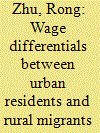| Srl | Item |
| 1 |
ID:
168505


|
|
|
|
|
| Summary/Abstract |
The article examines the various dimensions and underlying causes of informal employment in the Bangladesh labour market and the associated wage penalty. Based on labour force survey data for successive points, we trace the dynamics of employment in Bangladesh along the informal–formal divide over time. Given that wage differential remains a key feature concerning the two market segments, we have carried out mean and quantile decomposition exercises to estimate the wage penalty originating from informality. We find significant wage gaps between formal- and informal-paid employees, formal paid and informal day labour, and formal paid and informal self-employed. The wage gaps range between 65.0 per cent and 225.0 per cent. The gap arises from a combination of observed differences in human capital and job characteristics, and the wage premium accruing from formal employment.
|
|
|
|
|
|
|
|
|
|
|
|
|
|
|
|
| 2 |
ID:
103916


|
|
|
|
|
| Publication |
2011.
|
| Summary/Abstract |
This paper analyzes gender earnings gaps in Hong Kong using the 2006 by-census data. To explore the sources of gender earnings gaps, we decompose the gaps using the method proposed by Machado and Mata (2005). We have three major findings. First, gender earnings gaps are larger both in lower positions and in higher positions in the earnings distribution. Both the "glass ceiling effect" and the "sticky floor effect" exist in Hong Kong. Second, gender earnings gaps in higher positions are much explained by gender differentials in productivity-related characteristics; however, gender earnings gaps in lower positions are barely explained by these characteristics. Third, the effect of occupational segregation on gender earnings gaps depends on specific positions in the earnings distribution. In lower positions, occupational segregation is not a big problem and has little impact on gender earnings gaps; in higher positions, however, occupational segregation favors male workers and enlarges gender earnings gaps.
|
|
|
|
|
|
|
|
|
|
|
|
|
|
|
|
| 3 |
ID:
159025


|
|
|
|
|
| Summary/Abstract |
The paper studies the levels and changes in wage inequality among Chinese rural-urban migrants during 2002–2007. Using data from two waves of national household surveys, we find that wage inequality among migrants decreased significantly between 2002 and 2007. Our analysis on the wage distribution further shows that the high-wage migrants experienced slower wage growth than middle- and low-wage migrants—a primary cause of declining inequality of migrants. By using distributional decomposition methods based on quantile regression, we find that an overall between-group effect dominates in the whole wage distribution, which means that the change in returns to the characteristics (education, experience and other employment characteristics) plays a key role, but on the upper tails of the wage distribution, the within group effect (residual effect) dominates, implying that the unobservable factors or institutional barriers do not favor the migrants at the top tail of the wage distribution. We also study wage differential between migrants and urban natives, and find that though the wage gap is narrowed, the gap at the upper wage distribution is becoming bigger. Overall, the results suggest that there exists a strong “glass ceiling” for migrants in the urban labor market.
|
|
|
|
|
|
|
|
|
|
|
|
|
|
|
|
| 4 |
ID:
165370


|
|
|
|
|
| Summary/Abstract |
This article undertakes an examination of Bangladesh’s latest available Quarterly Labour Force Survey 2015–2016 data to draw in-depth insights on gender wage gap and wage discrimination in Bangladesh labour market. The mean wage decomposition shows that on average a woman in Bangladesh earns 12.2 per cent lower wage than a man, and about half of the wage gap can be explained by labour market discrimination against women. Quantile counterfactual decomposition shows that women are subject to higher wage penalty at the lower deciles of the wage distribution with the wage gap varying between 8.3 per cent and 19.4 per cent at different deciles. We have found that at lower deciles, a significant part of the gender wage gap is on account of the relatively larger presence of informal employment. Conditional quantile estimates further reveal that formally employed female workers earn higher wage than their male counterparts at the first decile but suffer from wage penalty at the top deciles.
|
|
|
|
|
|
|
|
|
|
|
|
|
|
|
|
| 5 |
ID:
147407


|
|
|
|
|
| Summary/Abstract |
This paper examines the wage differentials between urban workers and rural migrants in China's urban labor market. The wage differentials between the two groups are found to be higher at the top end than at the bottom part of the wage distribution in both 2002 and 2007. We decompose the distributional wage differentials between the two groups into a composition effect explained by differences in productivity characteristics, and a discrimination effect attributable to unequal returns to those characteristics. We find that the discrimination against migrant workers increases with the percentile of wage distribution in both 2002 and 2007. We also show that the discrimination against rural migrants has intensified during 2002–2007 throughout the wage distribution.
|
|
|
|
|
|
|
|
|
|
|
|
|
|
|
|